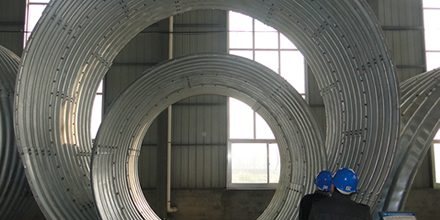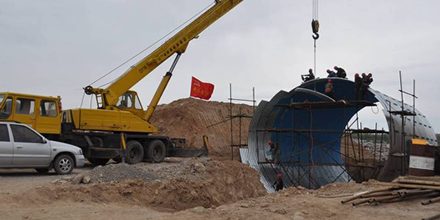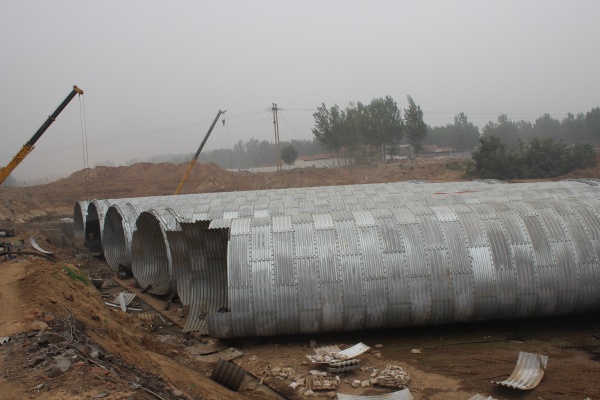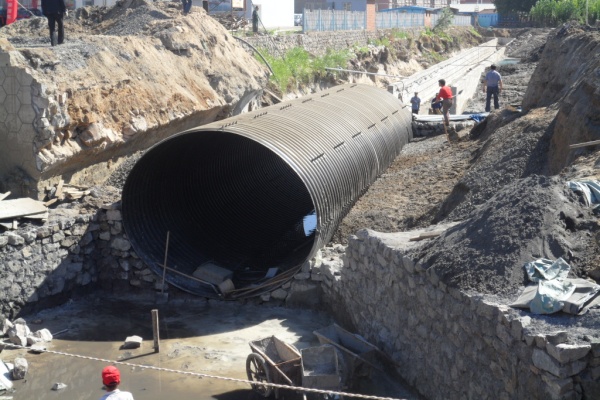The Production Of Corrugated Pipe Culverts
The advantages of steel corrugated pipe culverts: light weight, convenient transportation, simple construction, short construction period, low cost, minimal disturbance to the foundation, low requirements for the foundation, and good adaptability to deformation. Steel corrugated pipe culverts not only have the ability to adapt to the deformation of foundations, but also can solve the problem of culvert damage caused by uneven settlement of foundations. And it can better utilize the advantages of steel structures. The main disadvantage is corrosion resistance, but currently the design life of steel corrugated pipe culverts can reach and exceed 100 years. This is mainly achieved through effective measures such as galvanizing, aluminum plating, plastic immersion, painting, increasing wall thickness, and adding coatings. The use site should avoid immersion in corrosive sewage and erosion by mountain sand and gravel floods.
The usage ranges of corrugated pipe culverts: when the construction location has adverse such as permafrost, soft soil, swamp areas, expansive soil, collapsible loess, coal mine goaf, etc; High fill long culverts in mountainous. High fill long culverts in mountainous and hilly areas; Quick repair project for old culvert casing; Projects that are inconvenient to construct but require a short construction period; Construction access road. Within our province, it can be applied on highways in areas such as the Yellow River alluvial plain, mining areas, collapsible loess areas, mountainous hills, high fill deep trenches, and coastal soft soil swamps.
Sand and gravel foundation. Unscreened sand, crushed stone, gravel soil, and sandy soil are all ideal foundation materials.
The production of steel corrugated pipe culvert sections always follow factory processing. Small diameter pipe sections can be installed and processed as a whole pipe. When the diameter is 2m or more, each circumference can be divided into 3-9 pieces for processing, and bolt holes are set. The galvanizing process is also completed in the engineering processing stage. After being transported to the culvert location, the culvert pipe pieces are assembled and formed on site.Considering the high sea freight cost of the corrugated pipe culvert, normally, the overseas project use assembled types, which can be carried more in one container, so as to less the freight cost.
Soft foundation is choose to used on the corrugated pipe culvert construction, and it should be the same as the road side foundation,In sections with poor geological conditions such as soft soil areas, the same plan is also adopted for treatment. The excavation of the foundation pit should be carried out with a width three times of the proposed steel corrugated pipe culvert. If the construction site is too small, at least a working space of 1.2m or more beyond the span should be ensured. This is not only convenient for assembly, but also conducive to backfilling and compaction around the steel corrugated pipe culvert. The thickness of the culvert foundation should be 30-80cm from the bottom of the steel corrugated pipe culvert, and the material should be sandy soil, gravel or crushed stone soil with good permeability and good particle size distribution. A coarse sand cushion layer should be laid at the contact part with the corrugated steel plate The pipe body of the corrugated pipe laid under the embankment should have a reserved arch. The size of the pre arch should be set according to the possible settlement of the foundation, using a pre arch slope of 0.3% to 1%, and the maximum should not exceed 2%. To reduce the erosion of water flow on the bottom of the pipe, the longitudinal slope of the pipe bottom should generally not exceed 5 °. When the longitudinal slope of the culvert bottom is greater than 5 °, anti slip partition walls shall be installed every 3-5 meters at the top of the foundation bottom, and reinforced concrete shall be used at the end walls of the two openings to prevent slippage.
Sand and gravel foundation. Unscreened sand, crushed stone, gravel soil, and sandy soil are all ideal foundation materials.
Ordinary land foundation. Ordinary foundations with low bearing capacity require a certain thickness of foundation. If the undisturbed soil of the culvert bottom trench is strictly compacted, the corrugated pipe can also be directly placed on the foundation.
Rock foundation. For rock foundations, a portion of soft rock should be excavated and replaced with a layer of high-quality soil. Generally, the replacement thickness should not be less than 30cm. The weathered rock layer foundation cannot be used as a foundation and needs to be replaced with high-quality soil.
Soft soil foundation. When the culvert pipe is on a soft soil foundation, the soft soil subgrade needs to be treated. The treatment method for the culvert foundation is the same as that for the subgrade of the section, and then a high-quality sand and gravel cushion layer with a thickness greater than 30cm should be filled on it.
Collapsible loess foundation. Due to the special nature of the soil in collapsible loess, after excavation of the foundation pit, the base is backfilled with not less than 50cm of rubble concrete E-7 lime soil, and a high-quality sand and gravel cushion layer with a thickness of 30-80cm is backfilled on top of it.
Muddy river foundation. When the culvert is located in a river channel with perennial flowing water and silt, the general treatment is to use the method of throwing stones, with a thickness of about 1.5-3m. After stabilizing it, compaction machinery is used to compact it, and a gravel cushion layer of not less than 30cm is laid on it. If the riverbed is made of sandstone material, the corrugated pipe culvert shall be laid directly after compaction.
 Products
Products Application
Application

